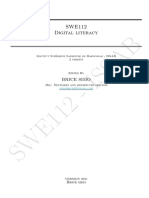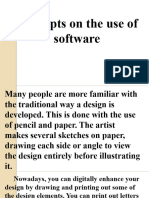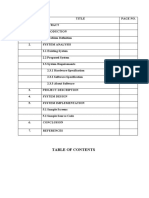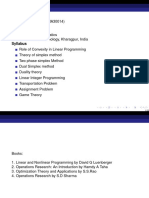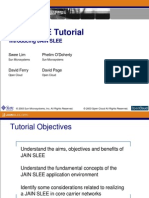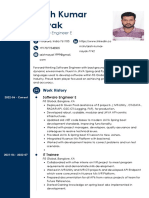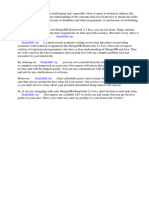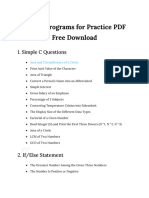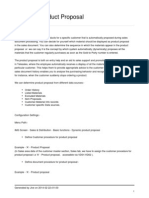Lesson 1 – Understanding the Tools and Equipment in ICT COMPUTER – the primary device used for writing code,
– the primary device used for writing code, running
programs and testing software
Learning Objectives
At the end of the lesson, learners are expected to: DESKTOP OR LAPTOP – depending on preferences or
requirements.
1. Develop the ability to identify various ICT tools and equipment, understand
their purposes, and learn the basic functions of each. Internal Components:
2. Gain hands-on experience with ICT equipment, focusing on safe handling
Central Processing Unit (CPU): The "brain" of the computer, responsible
and operation according to best practices and manufacturer guidelines for executing instructions.
3. Foster an appreciation for the role of ICT in enhancing work efficiency and Motherboard: The main circuit board that connects all other components.
problem-solving, leading to value-driven approach to technology Memory (RAM): Short-term data storage used for currently running
adoption. programs.
Unlocking of Content Vocabulary Storage Devices: Hard disk drives (HDDs) or solid-state drives (SSDs) for
COMPUTER – is a programmable device that stores, retrieves, and long-term data storage.
processes data Graphics Processing Unit (GPU): Handles graphics processing and
ICT – Information and Communication Technology is the infrastructure display.
and components that enable modern computing Power Supply Unit (PSU): Provides power to all components.
APPLICATION – In computing, an application, or app for short, is a External Components (Peripherals):
software program designed to help a computer user accomplish a task Input Devices: Allow users to interact with the computer (e.g., keyboard,
HARDWARE – consists of the physical parts of the computer system mouse, microphone).
SOFTWARE – is a collection of instructions, data, or computer programs Output Devices: Display or output information from the computer (e.g.,
monitor, speakers, printer).
used tom operate computers and execute specific tasks
Networking Hardware: Enables connection to networks (e.g., routers,
IMPORTANCE OF ICT IN TODAY’S WORLD switches).
1.Communication and Connectivity 2. SOFTWARE - refers to the programs, procedures, and routines that enable
the computer to perform specific tasks. It's the set of instructions that tell
2. Business Efficiency and Innovation
the hardware what to do, essentially making the computer functional.
3. Education and Learning
4. Economic Growth and Development and requirements IDE- An Integrated Development Environment is a software application
5. Adapting to Change that provides a comprehensive set of tools for software development within a
single, user-friendly interface.
What is a tool? Examples: Visual Studio Code, INtelliJ IDEA, Pycharm, Eclipse, Xcode
an element of a computer program (such as a graphics application) that activates
KEY FEATURES OF INTEGRATED DEVELOPMENT ENVIRONMENT (IDE)
and controls a particular function
• Code Editors: Lightweight alternatives to IDE’s for quick coding
Ex. a drawing tool and scripting
Examples: Sublime Text, Atom, Notepad ++
COMMON TOOLS AND EQUIPMENT IN ICT • Version Control Systems (VCS): Tools to manage changes to source
code over time.
IN COMPUTER PROGRAMMING Examples: Git, Subversion (SVN), Mercurial
1. HARDWARE - consists of the physical parts of the computer system. • Repositories and Collaboration Platforms:
The physical components of a computer system that can be touched Examples: GitHub, GitLab, Bitbucket
and seen, such as the keyboard, mouse, monitor, and the internal • Compilers and Interpreters: Tools that translate code into
components like the CPU, RAM, and hard drive. It's the tangible part of a executable programs.
computer. Examples: GCC (GNU Compiler Collection), Clang, Python, Interpreter, Node.js
• Debuggers: Tools to test and debug code
Examples: GDB (GNU Debugger), LLDB, built-in debuggers in IDE’s
� • Package Managers : Tools to manage software libraries and Compressed Air: Used to blow away dust and debris from computer
dependencies components.
Examples: npm (Node Package Manager), pip (Python Package Installer)
Maven,Gradle, NuGEt COMMON TOOLS AND EQUIPMENT IN DIGITAL VISUAL
• Build Automation Tools: Tools to automate the process of compiling
ARTS
code, running tests and deploying applications.
Digital visual art tools include both hardware and software components.
Examples: Jenkins, Travis CI, Circle CI, Make, Ant
Hardware includes computers, graphics tablets (with or without screens),
COMMON TOOLS AND EQUIPMENT IN COMPUTER and styluses. Software encompasses digital painting programs like
SYSTEM SERVICING (CSS) Photoshop, Procreate, and Krita, as well as vector graphics editors like
1. HAND TOOLS – These tolls help with hardware installation, repair Illustrator.
and maintenance.
A. Screwdrivers: Computer:
Flat Head Screwdriver - Used for loosening or tightening slotted screws. A desktop or laptop with sufficient processing power, RAM, and
Phillips Head Screwdriver - Used for loosening or tightening cross-head storage is essential for running digital art software and handling
screws. large files.
Torx Screwdriver: - Used for loosening or tightening screws with a star-
shaped
Depression, common in laptops. Digital Camera and scanners – capture images of their artwork or
Hex Driver (Nut Driver): Used for tightening nuts. scan traditional
B. Pliers: artwork to create digital versions
Needle-Nose Pliers: Used for gripping and holding small parts, especially Graphics Tablet/Drawing Pads
in tight spaces. These tablets and drawing pads allow artists to draw directly onto the
Side-Cutting Pliers (Wire Cutters): Used for cutting and stripping wires. screen (display
C.Anti-static wrist strap: Prevents electrostatic discharge (ESD) damage tablets) or onto a surface that translates their movements into digital
to components. strokes on the
computer screen.
2.DIAGNOSTIC SOFTWARE- Software tools to diagnose hardware Graphic Design Software – (Adobe Photoshop, Illustrator) – these tools
issues, check allow
system performance, and troubleshoot problems students to manipulate images , create digital art and design graphics.
3D Modelling Software – (Blender, AutoDesk Maya) for students
3.CABLE TESTERS AND MULTIMETERS – These tools help verify cable interested in 3D art
connections and measure electrical parameters and animation.
COMMON TOOLS IN TELECOMMUNICATION -
Multimeter: Used to test voltage, current, and resistance in circuits. communication over a distance by cable, telegraph, telephone, or
Cable Tester: an electronic device used to verify the electrical broadcasting.
connections in a cable, ensuring it's wired correctly and capable of HARDWARE
transmitting data or signals as intended. Modems and Routers – Devices that modulate and demodulate
signals for transmission over telephone lines or cable systems and
4.CLEANING KITS – KEEPING COMPUTERS DUST FREE IS ESSENTIAL route data between devices on a network
FOR OPTIMAL PERFORMANCE Examples: DSL modems, cable modems, wireless route
Switches and Hubs – Networking devices that connect multiple
typically include a variety of tools and solutions to effectively remove devices within a network, facilitating communication between them.
dust, debris, and grime from your computer and its Examples: Ethernet switches, network hubs
components. Common items include compressed air, lint-free cloth , Repeaters and Extenders – Devices that amplify or regenerate
cleaning solution, brushes, and keycap pullers for keyboards signals to extend
the range of a network
Lint-Free Cloth: Used for cleaning delicate components without leaving Examples: signal boosters, wi-fi extenders
behind fibers or scratches. Antennas – Devices that transmit and receive radio waves for
wireless
communication.
� Examples: yagi antennas, parabolic antennas, dipole antennas 2. System software. These software programs are designed to
Base Station – equipment that connects mobile devices to a run a computer's application programs and hardware. System
network in cellular software coordinates the activities and functions of the
and radio communications hardware and software. In addition, it controls the operations of
Examples: cell towers, microcells, femtocell the computer hardware and provides an environment or
SOFTWARE platform for all the other types of software to work in. The OS is
Network Management Software – Tools for monitoring, the best example of system software; it manages all the other
managing and computer programs. Other examples of system software
troubleshooting network performance and include the firmware, computer language translators and
connectivity system utilities.
Examples: Solar Winds Network Performance Monitor PRTG 3. Driver software. Also known as device drivers, this software is
Network Monitor, often considered a type of system software. Device drivers
Nagios control the devices and peripherals connected to a computer,
Communication Protocols – Software Protocols that define enabling them to perform their specific tasks. Every device that
rules for data is connected to a computer needs at least one device driver to
Exchange over a network. function. Examples include software that comes with any
Examples: TCP/IP (Transmission Control Protocol/Internet nonstandard hardware, including special game controllers, as
Protocol), VoIP well as the software that enables standard hardware, such as
(Voice Over Internet Protocol), SIP (Session Initiation USB storage devices, keyboards, headphones and printers.
Protocol 4. Middleware. The term middleware describes software that
Telephony Software – Applications for managing voice mediates between application and system software or between
communication over two different kinds of application software. For example,
networks. middleware enables Microsoft Windows to talk to Excel and
Examples: Asterisk, FreeSWITCH, Skype for Business. Word. It is also used to send a remote work request from an
application in a computer that has one kind of OS, to an
TYPES OF SOFTWARE application in a computer with a different OS. It also enables
newer applications to work with legacy ones.
1. EXPLICITATION
5. Programming software. Computer programmers use
DEFINITION OF SOFTWARE programming software to write code. Programming software and
Software is a set of instructions, data or programs used to programming tools enable developers to develop, write, test and
operate computers and execute specific tasks. It is the opposite of hardware, debug other software programs. Examples of programming
which describes the physical aspects of a computer. Software is a generic term software include assemblers, compilers, debuggers and
used to refer to applications, scripts and programs that run on a device. It can be interpreters
thought of as the variable part of a computer, while hardware is the invariable How does software work? All software provides the directions
part. and data computers need to work and meet users' needs. However, the two
The two main categories of software are application software different types -- application software and system software -- work in
and system software. An application is software that fulfills a specific need or distinctly different ways. The dimensions of software quality include the
performs tasks. System software is designed to run a computer's hardware and following characteristics:
provides a platform for applications to run on top of. The dimensions of software quality include the following
characteristics:
1. Application software. The most common type of software, 1. Accessibility. The degree to which a diverse group of people,
application software is a computer software package that including individuals who require adaptive technologies such as
performs a specific function for a user, or in some cases, for voice recognition and screen magnifiers, can comfortably use the
another application. An application can be self-contained, or it software.
can be a group of programs that run the application for the user. 2. Compatibility. The suitability of the software for use in a variety
Examples of modern applications include office suites, of environments, such as with different OSes, devices and browsers.
graphics software, databases and database management 3. Efficiency. The ability of the software to perform well without
programs, web browsers, word processors, software wasting energy, resources, effort, time or money.
development tools, image editors and communication 4. Functionality. Software's ability to carry out its specified
platforms. functions.
�5. Installability. The ability of the software to be installed in a
specified environment.
6. Localization. The various languages, time zones and other such
features a software can function in.
7. Maintainability. How easily the software can be modified to add
and improve features, fix bugs, etc.
8. Performance. How fast the software performs under a specific
load.
9. Portability. The ability of the software to be easily transferred
from one location to another.
10. Reliability. The software's ability to perform a required function
under specific conditions for a defined period of time without any
errors.
11. Scalability. The measure of the software's ability to increase or
decrease performance in response to changes in its processing
demands.
12. Security. The software's ability to protect against unauthorized
access, invasion of privacy, theft, data loss, malicious software, etc.
13. Testability. How easy it is to test the software. 14. Usability.
How easy it is to use the software.
14. Usability. How easy it is to use the software.
2. Worked Example
1. Operating System (OS)
Example: Installing a new application on Windows 10
Step 1: Download the installation file for the application.
Step 2: Double-click the downloaded file to begin the installation
process.
Step 3: Follow the on-screen instructions to complete the
installation.
Step 4: Once installed, you can find the application in the Start
Menu and run it.
2. Application Software Example: Creating a presentation in
Microsoft PowerPoint.
Step 1: Open PowerPoint and select a template or create a new
blank presentation.
Step 2: Add new slides and input content such as text, images, and
videos.
Step 3: Apply transitions and animations to enhance the
presentation.
Step 4: Save the presentation and practice your slideshow.
3. Utility Software
Example: Running a disk cleanup on a computer. Step 1: Open
the Disk Cleanup utility from the Start Menu. Step 2: Select the drive
you want to clean up and click “OK”. Step 3: Check the boxes for the
types of files you want to delete and click “OK”. Step 4: Confirm the
action and wait for the cleanup to finish.

















































